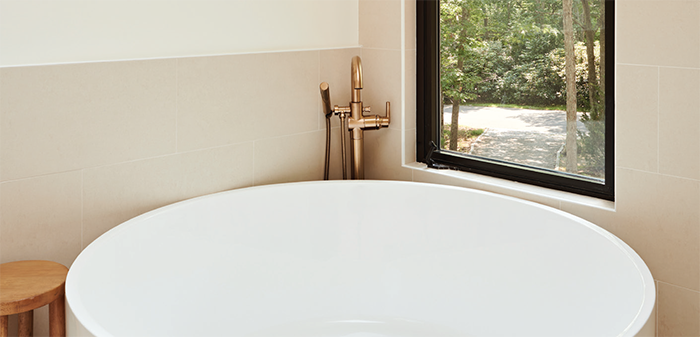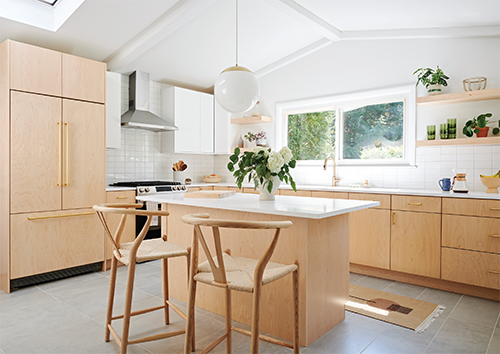
The future of sustainable home building. By Zach Barnes-Corby
Over the past decade, sustainability has become an increasingly ubiquitous term in the world of design and architecture. The motivating reasons are not all too surprising. As man-made climate change solidifies as a global reality, both consumers and designers have realized the importance of not only cultivating building practices with a minimal impact on the environment, but also of crafting spaces that can help us forge fundamentally new relations between the human, built, and natural worlds.
In our business, we’ve seen homeowners all over the US increasingly prioritize reduced environmental impact in their renovation projects. It’s come to life in a number of ways: from prioritizing the use of sustainable materials and maximizing energy efficiency, to working with quality products that won’t have to be replaced for decades to come. It’s a trend that we’ve seen echoed within the industry at large.
Holistic approach
These projects – though only a sliver of the broader world of sustainable design – reveal that sustainability isn’t a singular strategy, but rather a holistic approach that can be practiced in a number of ways. Understanding the different dimensions behind this concept can help us both navigate the trends that dominate in the present-day and imagine the future potential of these emergent practices as well.
To start, it helps to go back in time to understand exactly how sustainability got to be in present discourse. There are plenty of cultures throughout history that have practiced sustainable architecture, though rarely under that name. Take, for example, the living tree bridges (or jing kieng jri in the local language, Khasi) which complicate the distinctions between built and natural systems, or the ways in which materials, like mud, have long provided a renewable, energy-efficient material with which to build (as explored by a number of West African vernacular building traditions). This hidden history reveals that often-marginalized building traditions have long been doing what has only recently caught on in modern design.
In the West, the notion of sustainability became more formalized and popularized in the 60s and 70s, riding off the broader wave of environmental consciousness that arose in that period of time. During this stage, architects began to incorporate more sustainable materials and energy-efficient design into their work.
Optimizing sustainable practices
Today, sustainability has grown to be a key consideration in the field of architecture, with increasing specializations dedicated to exploring and discovering new ways in which it might be expressed, and inventing new materials to do so.
One of the biggest shifts in recent decades, however, has been the move towards a systemic, holistic framework when it comes to sustainability. We’re increasingly realizing that sustainability isn’t simply about the materials that go into a house, though that may be the most visible thing to latch onto. Rather, it’s about all the steps that went into its construction, all the systems working in concert to bring it to life. That includes the environmental costs of shipping a material to the build site, the impact of powering that space through its lifetime, the frequency with which materials might need to be replaced, the partners that you’re using to actually construct the space. It’s why optimizations across all points of a project have become increasingly important in creating sustainable practices – something that technology has helped enable.
Cradle-to-cradle design
As we look towards what sustainable design and architecture might look like in the future, there are myriad ways it might express itself. Not only will the importance of eco-friendly materials continue to grow, but so will the importance of quality materials – which help ensure that a building or home remains sustainable over time by creating it with maintenance and repairs in mind, and by using materials that are durable and long-lasting.
Moreover, what gets to count as a material might itself change (mud, as mentioned earlier, is beginning to be employed in certain areas for its insulating and cooling properties). The ‘cradle-to-cradle’ philosophy of William McDonough – which attempts to reframe ‘design as a positive, regenerative force’ – is one such example of how we might holistically shift our thinking about materials in the future.
We’re also seeing the growing integration of natural and built spaces. In our practice, there’s been an increasing number of homeowners who have wanted to integrate their homes within the surrounding environment – bringing the ‘outside in,’ so to speak. Large windows, indoor greenery, and natural materials have been ways homeowners have been able to achieve this on a more residential level.
At a larger scale, many architects and residential designers are incorporating green roofs, living walls, and other forms of vegetation into their designs. This not only provides a space for plants and wildlife, but it also helps to improve air quality and reduce the urban heat island effect. Architecture firms like the Bjarke Ingles Group – with projects like 8 House or the Waste-to-Energy Plant – are gesturing towards how these worlds might intersect.
Technology integrations and process optimizations are also a great way to reduce the environmental impact of a build, though it may be a bit less romantic. Figuring out how to recycle materials, source locally, work with businesses in the community, and streamline aspects, such as delivery and storage, are all things that we’re working on to facilitate a less impactful build experience.
Though sustainability has come a long way, it still has a long way to go. The exciting thing is that we’re seeing growing excitement among designers, architects, and homeowners to really explore this space. As our brief survey has made clear, there’s no singular way that this will come to life – but that’s exactly what makes it all the more exciting.
For a list of the sources used in this article, please contact the editor
Zach Barnes-Corby
www.blockrenovation.com
Zach Barnes-Corby is Head of Construction at Block Renovation, an industry leader of end-to-end renovation platforms that manages contracts, permitting, payments, design, vendors, and contractors – all in one place. Renovations are both an aspirational journey, but also fraught with anxiety and risk as they frequently take longer, cost more, and cause more stress than anticipated. Block Renovation is the platform where contractors AND homeowners manage major renovation projects leading to simpler, faster, and higher trust for all users.